The Ethernet Card Market is estimated to be valued at USD 7.45 billion in 2025 and is expected to reach USD 13.90 billion by 2032, exhibiting a compound annual growth rate (CAGR) of 9.3% from 2025 to 2032.
The Ethernet card market is experiencing steady growth driven by increasing demand for higher connectivity speeds across industries.
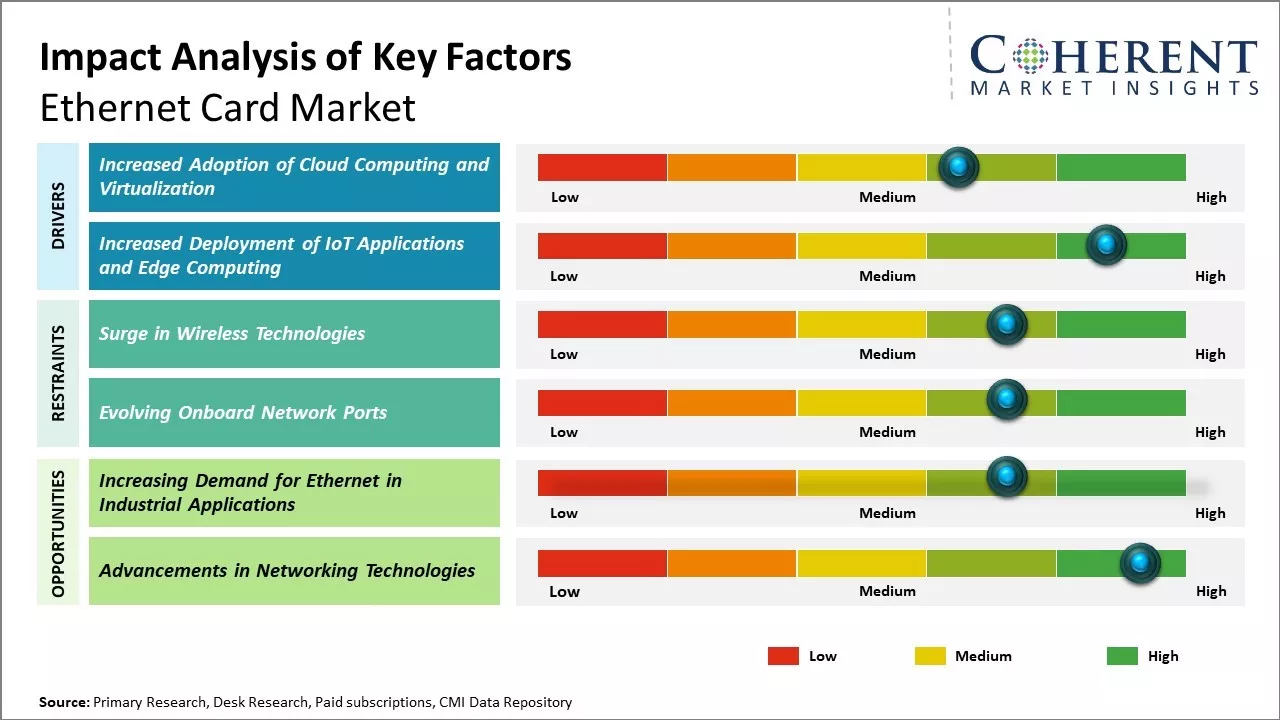
Discover market dynamics shaping the industry: Download Free Sample
Factors such as the development of smart applications and adoption of advanced technologies such as autonomous driving, industrial IoT, and AI are fuelling the need for high-speed connectivity. Furthermore, the faster adoption of 5G networks globally is also augmenting demand for high-speed Ethernet cards to support connectivity requirements of various end-use verticals. Growing network infrastructure and transition towards cloud-based applications offer lucrative opportunities for vendors in this market.
Increased Adoption of Cloud Computing and Virtualization
As businesses across industries increasingly adopt cloud computing and virtualization technologies, the demand for high-performance Ethernet cards is expected to rise significantly. With cloud and virtual environments allowing businesses to flexibly spin up and manage virtual machines on-demand, there is a growing need for network interface cards that can support numerous simultaneous connections and handle high-bandwidth tasks. Ethernet network adapters play a vital role in enabling seamless connectivity between physical and virtual devices, delivering high-speed data transmission for storage access, inter-VM communication, and other performance-intensive operations.
A major factor driving this transition is the cost advantages that cloud and virtualization provide. Migrating IT infrastructure and applications to the cloud allows smaller and medium enterprises to eliminate upfront capital expenditures on expensive hardware and shift to an operational expenditure model. It also relieves them of the responsibilities of managing physical servers and other infrastructure. For larger enterprises, virtualization offers improved hardware utilization through server consolidation. This translates into significant savings on power, cooling, and real estate costs associated with data centers. As more workloads shift to virtual and cloud platforms, there will be a growing need for Ethernet cards with advanced features like SR-IOV, VM queue support, and robust switching capabilities to enable high-speed networking between large numbers of virtual machines and cloud instances.
According to stats from the UN Broadband Commission's 2021 report on the socioeconomic benefits of connectivity, the global IP traffic grew by 26% in 2020 alone and is projected to grow nearly threefold between 2020 and 2025.
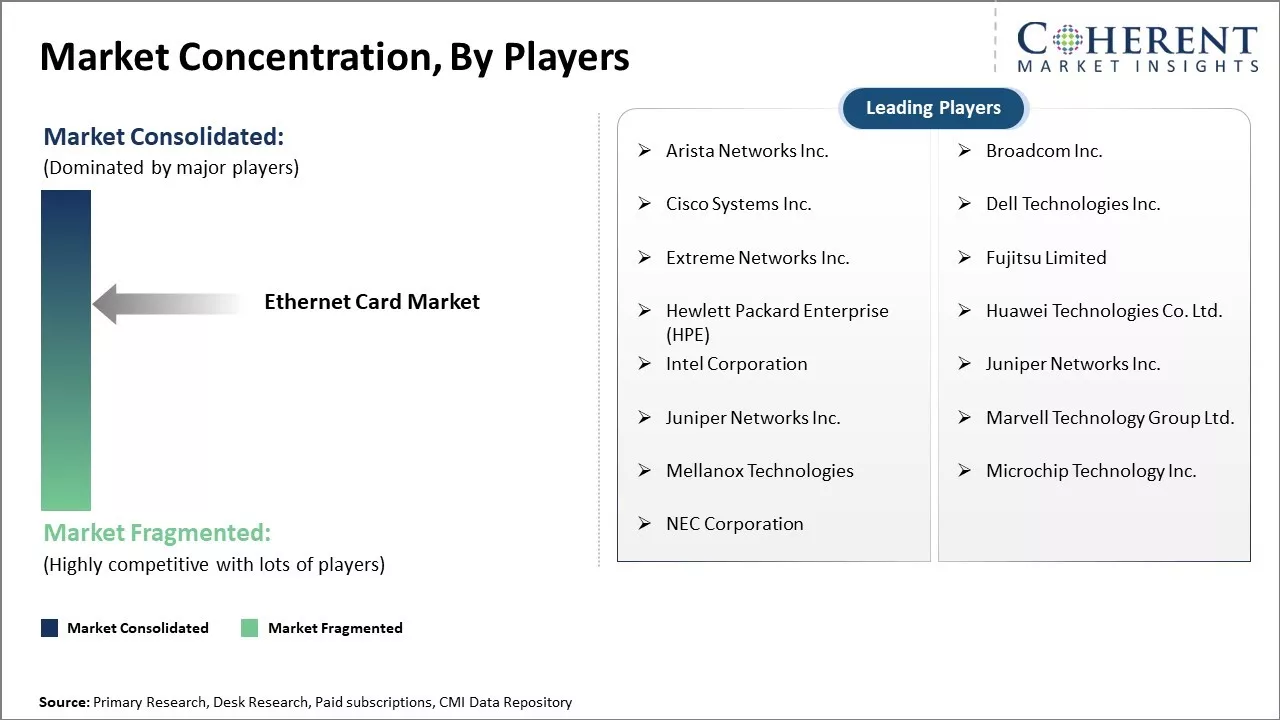
Get actionable strategies to beat competition: Download Free Sample
Increased Deployment of IoT Applications and Edge ComputingAnother major driver fuelling growth in the Ethernet card market is the proliferation of IoT applications and edge computing deployments across different verticals. The growing number of connected devices generating and consuming data at the edge is driving the need for robust network infrastructure to support these decentralized computing environments. Edge networking plays a vital role in minimizing latency and improving performance and reliability for bandwidth-intensive and latency-sensitive IoT applications. With many industrial enterprises and manufacturing facilities implementing IoT sensor networks, production line connectivity, and robotics/automation solutions, reliable edge networking using high-performance Ethernet cards is becoming increasingly indispensable.
Areas seeing increased IoT deployments like smart cities, logistics, healthcare, and retail are especially promising markets. For instance, connected infrastructure elements in smart cities will rely on edge computing nodes embedded with multiple Ethernet ports to support a large number of sensors, cameras and networked devices. Logistics facilities are deploying networked robots, conveyor systems, barcode scanners and more to optimize warehouse operations.
According to the International Telecommunications Union, in 2022, the number of individuals using the internet increased by 7.6% between 2020 and 2021, reaching 4.9 billion users globally by January 2022. With more people and devices coming online every day, there is massive opportunity for components like Ethernet cards that build out networking infrastructure.
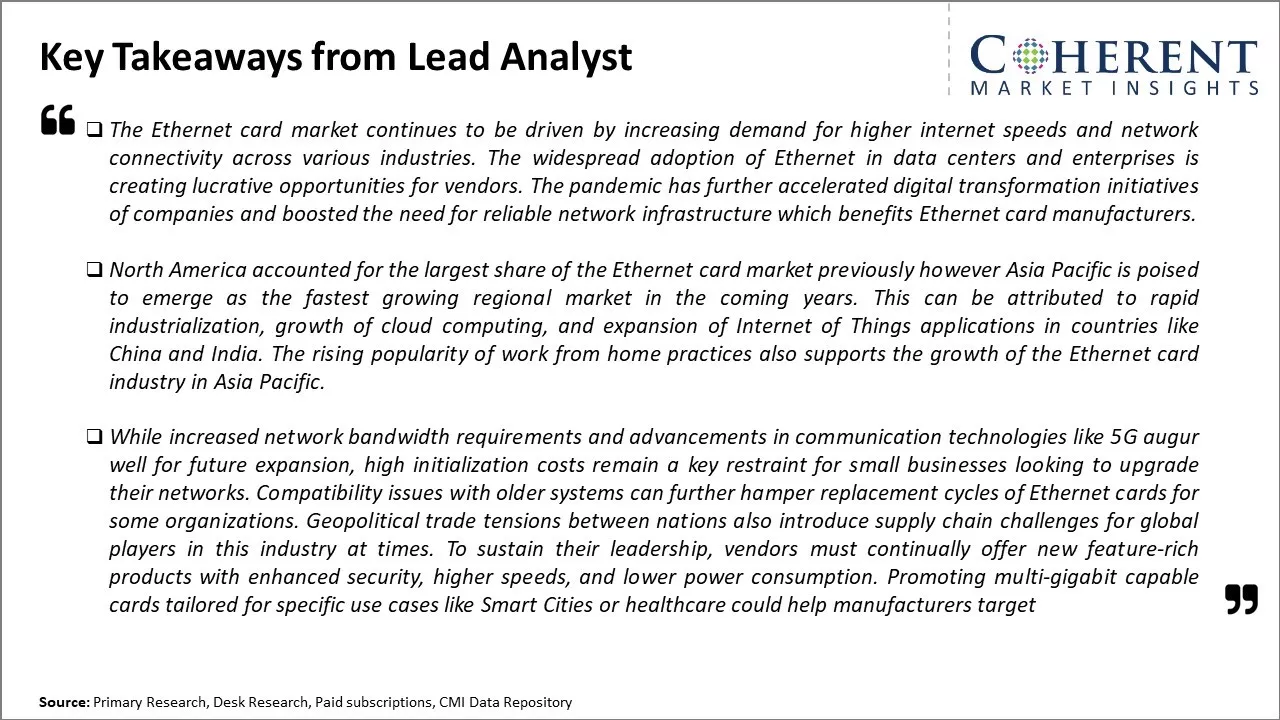
To learn more about this report, Download Free Sample
Market Challenge Surge in Wireless TechnologiesOne of the main challenges facing the Ethernet card market is the rising popularity of wireless technologies that provide network connectivity without wires. As Wi-Fi and mobile networks become faster and more widely available, the need for traditional wired Ethernet connections in devices is decreasing. Additionally, improved CPU performance means on-board networking ports are meeting most needs without the need for add-in Ethernet cards. Upgrading to newer Ethernet standards also requires replacing existing network infrastructure, representing additional costs.
Market Opportunitie Increasing Demand for Ethernet in Industrial Applications
The industrial sector is undergoing digital transformation, with the adoption of technologies such as Industrial Internet of Things (IIoT) and Industry 4.0. Ethernet cards play a critical role in enabling seamless connectivity and data exchange within industrial networks. There is an opportunity for Ethernet card manufacturers to develop specialized industrial-grade Ethernet cards that meet the specific requirements of rugged environments, support real-time communication, and ensure reliable connectivity in industrial applications. According to the 2021 UNIDO report, over 50% of automotive companies have active IIoT projects underway. As digital transformation of factories gathers pace, there will be rising need to integrate industrial field devices onto the plant floor network with high-speed, secure, and reliable Ethernet connectivity.
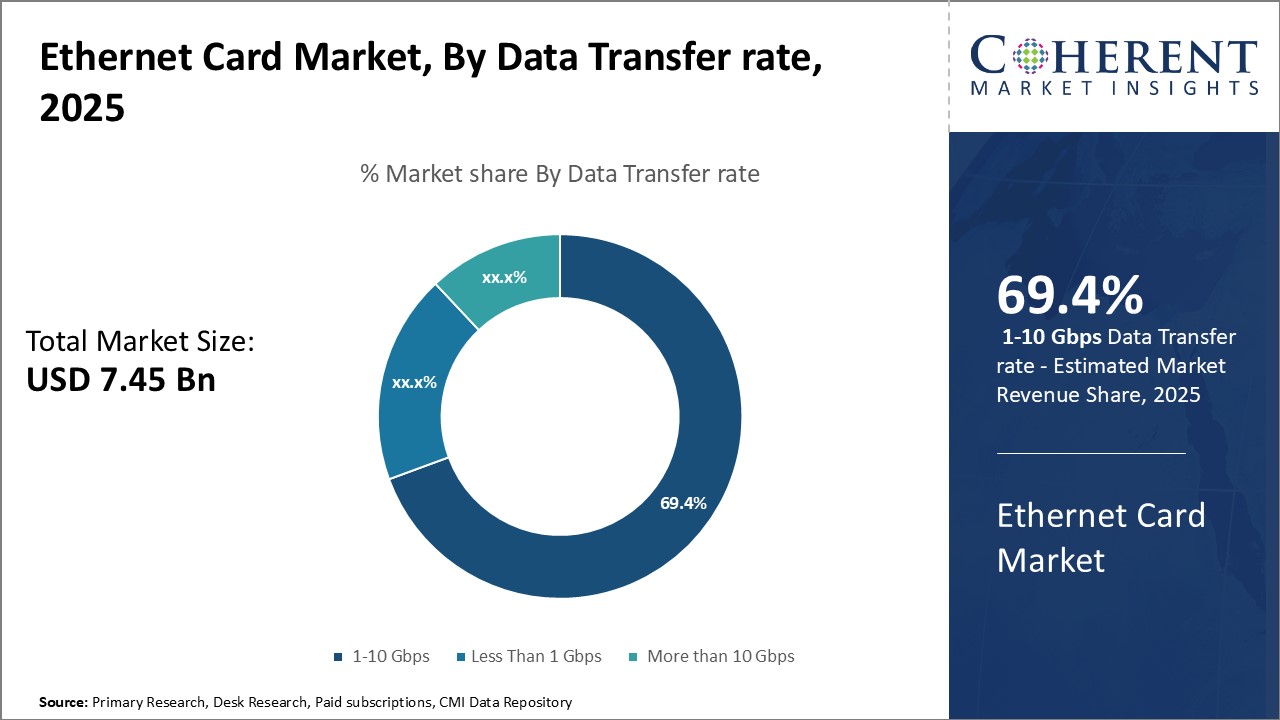
Discover high revenue pocket segments and roadmap to it: Download Free Sample
Insights, By Data Transfer Rate- Rising Demand for High Bandwidth Drives Growth of the 1-10 Gbps Ethernet Card SegmentThe 1-10 Gbps segment within the Ethernet card market is estimated to occupy the largest share of 69.4% in 2025, due to increasing needs for connectivity supporting high-speed data transfer. Various applications like video streaming, cloud computing and storage demand bandwidth capable of smoothly handling large file sizes and real-time data. Devices with multiple network interfaces also push requirements for aggregated throughput above 1 Gbps. As high-definition content and virtual environments become more prevalent in corporate and consumer applications, the minimum acceptable performance threshold continuously rises. This prompts more organizations to adopt network infrastructure rated for speeds aligning with present and near-future requirements. meanwhile, declining production costs make multi-Gbps solutions economically feasible for a wider user base.
Growth in this segment also corresponds to the deployment of 40 and 100 Gbps switches and routers at Internet exchange points, data centers and large campuses. Wider proliferation of 10 Gigabit Ethernet and emerging uptake of 25/40GbE allows aggregation of traffic from multiple 1 Gbps ports. This provides the bandwidth multiplication needed to avoid bottlenecks when traffic must pass through multiple network tiers.
Insights, By End-use Industry- IT and Telecom Drives Demand across the Ethernet Card Industry
As the largest consumer vertical, the IT and Telecom industry is estimated to hold the largest share of 48.32% in 2025. Infrastructure upgrades by data centers, internet providers and mobile carriers require the massive deployment of high-performance switching and interconnect solutions.
Complex cloud computing and 5G architectures involving numerous virtual and physical network elements depend on the reliability and scalability of Ethernet technologies. Cards supporting speeds from 1GbE to 100GbE allow flexibility in architecting vast internal networks and linking diverse third-party systems. Meanwhile, relentless digital transformation across other industries increases reliance on IT services and connectivity provided by telecom operators. Heavy computing workloads generated from IoT, video, gaming and other bandwidth-intensive consumer/enterprise applications mandate continuous expansion and modernization of IT infrastructure.
Within enterprises, IT departments also remain the primary procurers of Ethernet cards for campus networks, server connectivity, storage area networks and client devices. Renovation of dated infrastructure to high-speed Ethernet standards and the growth of network edges associated with BYOD, branch offices and cloud-delivered systems stimulates replacement and new installation of network interface cards. The ability of Ethernet to support consolidated voice, data and video transmission over a single network further elevates its importance across the IT and telecommunications ecosystems. This makes the vertical uniquely positioned to power expansion across the broader Ethernet card industry.
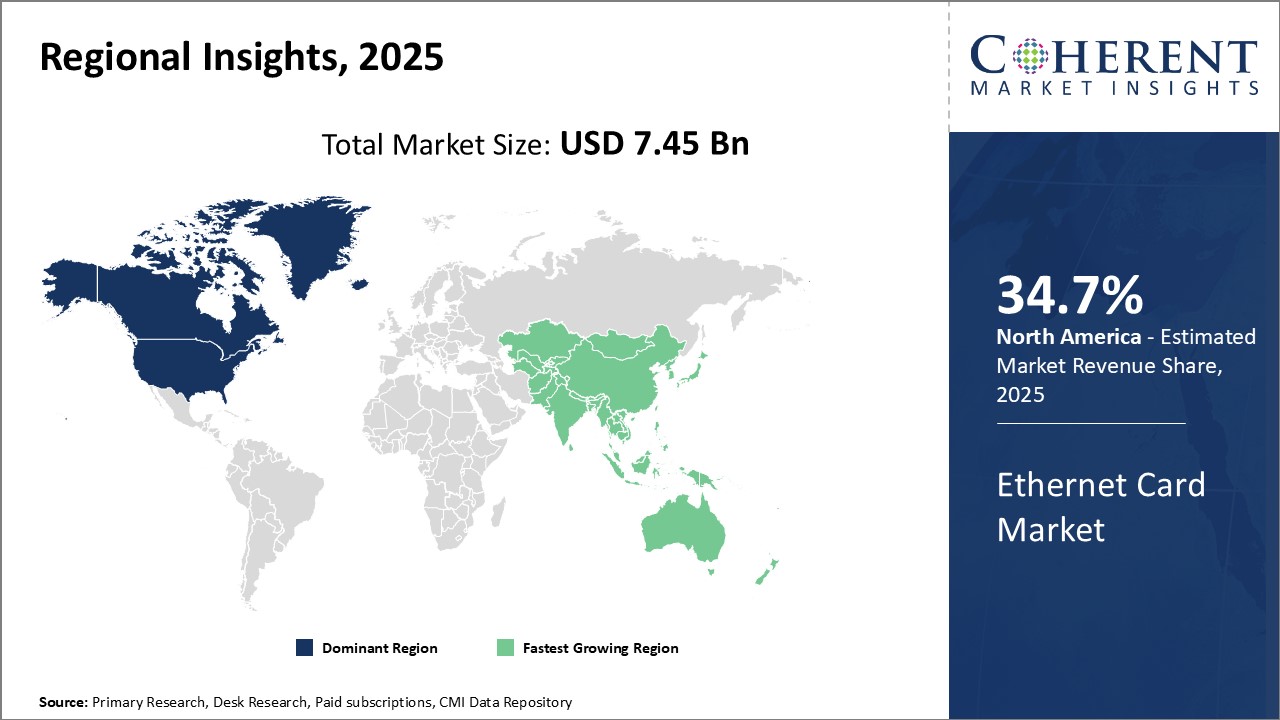
Need a Different Region or Segment? Download Free Sample
North America has firmly established itself as the dominant region in the global Ethernet card market and is estimated to hold the largest share of 34.7% in 2025. The presence of major industry players such as Intel, Broadcom, and Cisco gives the region an edge over others. These companies have been investing heavily in R&D to continuously innovate and introduce newer products. Additionally, growth of data center capacity and emergence of technologies such as cloud computing, IoT and big data analytics have driven the demand for high-speed Ethernet cards in the region.
The U.S. alone accounts for over 50.5% of the total Ethernet card shipments in North America due to a well-developed IT infrastructure and rising internet penetration. Majority of hyperscale data center build outs are also happening in the US, boosting expenditures on network infrastructure including Ethernet switches and adapters. While enterprises of all sizes are automating their network infrastructure and upgrading to multi-gigabit network speeds. This has created a consistent requirement for server and desktop adapters. Furthermore, heavy investments in 5G networks are expected to spur opportunities for manufacturers in the coming years.
Moving to Asia Pacific, this region has emerged as the fastest-growing market for Ethernet cards globally and is expected to do the same in 2025 with CAGR of 11.77% in 2024. The growth can be attributed to rapid digitalization initiatives underway in various countries. Growing GDPs and consumption levels are propelling investments into networking and connectivity domains across Asia. China, in particular, is playing a pivotal role as it looks to establish itself as a global manufacturing hub. Easy availability of raw materials and cheap labor costs have made the country an export powerhouse. Taiwan too has carved a niche for itself in this space by providing components to vendors across the world. Growing export focus of players based in these nations is driving regional shipments. Countries like India and South Korea are also aggressively deploying high-speed broadband and wireless infrastructure to aid their digital agendas. This has translated into significant Ethernet card procurement. However, relatively higher prices of some components in Asia compared to global benchmarks is one challenge that needs to be addressed. But with market saturation in developed markets, Asia Pacific is expected to be the prime revenue driver of this industry over the medium term.
Ethernet Card Market Report Coverage
| Report Coverage | Details | ||
|---|---|---|---|
| Base Year: | 2024 | Market Size in 2025: | USD 7.45 Bn |
| Historical Data for: | 2020 To 2024 | Forecast Period: | 2025 To 2032 |
| Forecast Period 2025 to 2032 CAGR: | 9.3% | 2032 Value Projection: | USD 13.90 Bn |
| Geographies covered: |
|
||
| Segments covered: |
|
||
| Companies covered: |
Arista Networks Inc., Broadcom Inc., Cisco Systems Inc., Dell Technologies Inc., Extreme Networks Inc., Fujitsu Limited, Hewlett Packard Enterprise (HPE), Huawei Technologies Co. Ltd., Intel Corporation, Juniper Networks Inc., Marvell Technology Group Ltd., Mellanox Technologies, Microchip Technology Inc., NEC Corporation |
||
| Growth Drivers: |
|
||
| Restraints & Challenges: |
|
||
Uncover macros and micros vetted on 75+ parameters: Get instant access to report
*Definition: The Ethernet card market includes companies that manufacture and sell network interface cards that allow devices such as computers and servers to connect to Ethernet-based networks. Ethernet cards, also known as network interface controllers or network cards, are expansion cards that are installed into expansion slots on the motherboard of a device. They provide the physical connection between the host device and an Ethernet-based network infrastructure, allowing devices to communicate and share resources over the network. The Ethernet card market caters to businesses, networking hardware manufacturers, and consumers.
Share
Share
About Author
Raj Shah is a seasoned strategy professional with global experience, from strategy to on-the-ground operational improvements. In last 13 years, he has executed number consulting projects focused on consumer electronics, telecom and consumer-internet business leading multiple long-term engagements towards mobilizing and executing on break-through strategy - leading to tangible sales results. Raj is also acting as a strategy consultant for one of the leading online hyper local service providers in India, contributing to their growth through critical strategic decisions. Raj usually spends time after office in talking to the passionate entrepreneurs, regardless of their funding status.
Missing comfort of reading report in your local language? Find your preferred language :
Transform your Strategy with Exclusive Trending Reports :
Frequently Asked Questions
Joining thousands of companies around the world committed to making the Excellent Business Solutions.
View All Our Clients